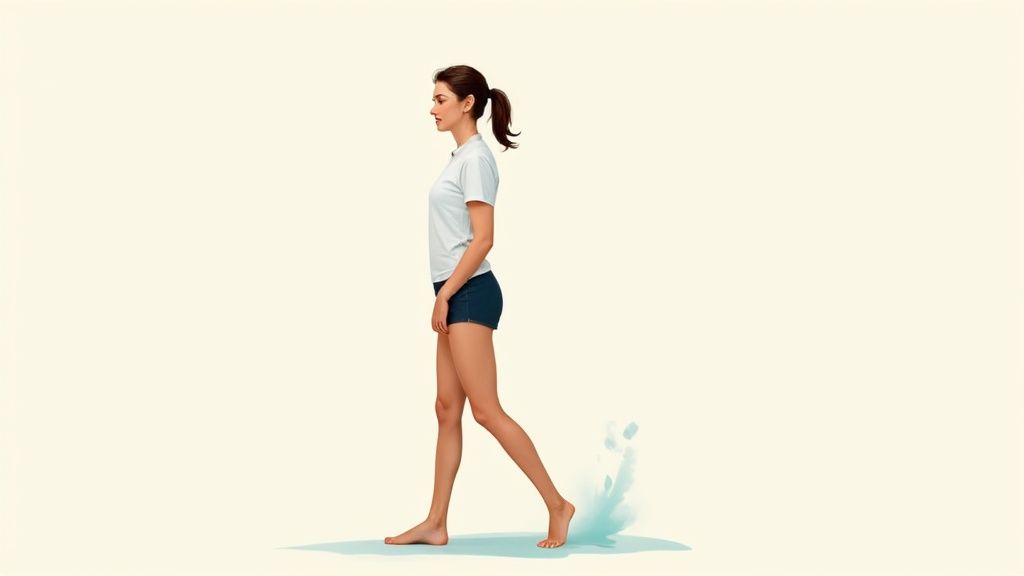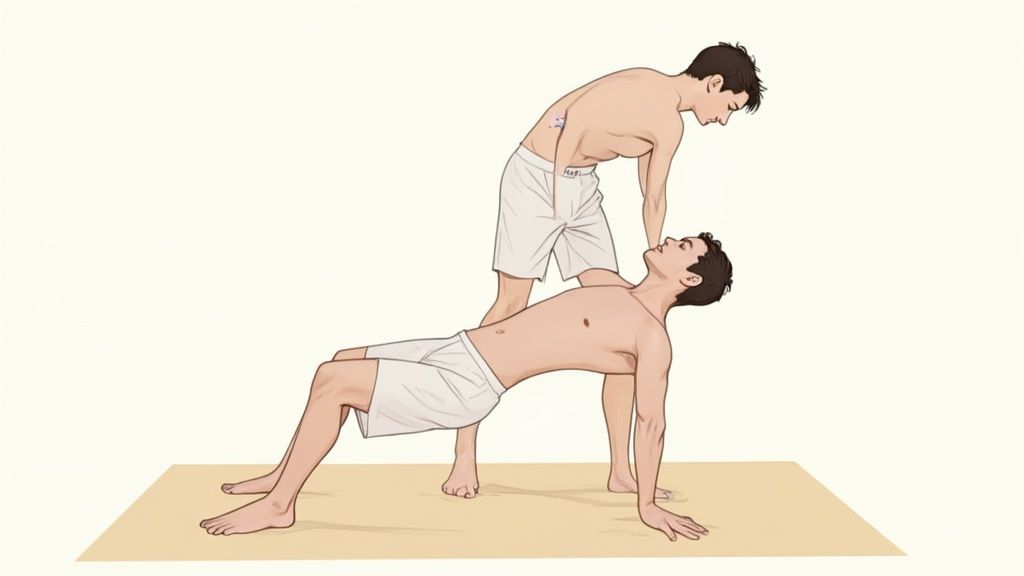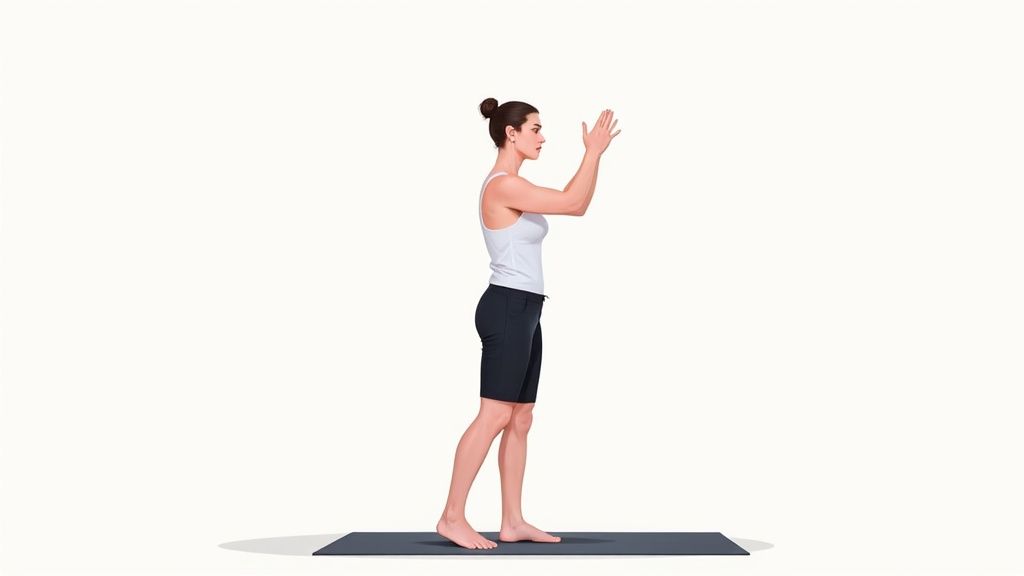10 Proven Posture Correction Exercises That Transform Your Body Alignment
Understanding Why Your Posture Is Holding You Back

Good posture does more than just make you look confident - it fundamentally affects your health and wellbeing. By understanding what causes poor posture, we can better address the root problems and create lasting improvements. Let's explore why posture matters so much and what you can do about it.
The Domino Effect of Poor Posture
Poor posture often develops gradually through daily habits that seem harmless at first. When you spend hours hunched over your computer or looking down at your phone, it puts extra strain on your neck and shoulder muscles. Over time, these overworked muscles become tight and pull your body further out of alignment, creating a cascade of issues throughout your body.
Think about breathing - when you slouch, it compresses your chest and diaphragm, making it harder to take full breaths. This reduced oxygen intake can leave you feeling tired and foggy-headed. It can even impact your ability to think clearly and regulate your emotions. In contrast, sitting and standing tall opens up your chest, allowing your lungs to fully expand with each breath.
Beyond the Physical: The Mental and Emotional Impact
The effects of posture go deeper than just body mechanics. Research shows that how we hold ourselves directly influences our confidence and mood. For example, people who maintain upright posture tend to feel and appear more self-assured. Meanwhile, chronic slouching can feed into feelings of low confidence, creating a negative cycle where poor posture and negative self-image reinforce each other.
Why Quick Fixes Fall Short
It's tempting to try quick solutions like posture braces or occasional stretching. While these might provide temporary relief, they don't address the underlying muscle imbalances and movement patterns that led to poor posture in the first place. Real improvement requires a complete approach that includes targeted strengthening exercises and increased awareness of how you hold yourself throughout the day.
Spotting the Early Warning Signs
Catching posture problems early makes them much easier to fix. Watch for common signs like rounded shoulders, forward head position, tilted pelvis, or an excessively arched lower back. Frequent headaches and neck or back pain can also signal that your posture needs attention. By recognizing these warning signs and taking action through proper exercises and mindful movement, you can prevent minor issues from becoming chronic problems that are harder to correct.
Neck and Shoulder Exercises That Actually Work

Most of us spend hours hunched over computers and phones each day, putting major strain on our necks and shoulders. Adding targeted exercises for these areas is essential for maintaining good posture and preventing pain. Let's explore some proven movements that can help realign your body and relieve discomfort.
Precision Chin Tucks: Realigning Your Head
Chin tucks are one of the most effective exercises for fixing forward head posture caused by looking down at screens. The key is proper form - think about sliding your head straight back horizontally, rather than just tilting your chin down. Keep your gaze level as you gently retract your chin, feeling the muscles at the base of your skull engage. Hold for 3-5 seconds. Regular practice helps strengthen these muscles to naturally pull your head back into alignment.
Dynamic Scapular Stabilization: Strengthening Your Shoulders
The muscles around your shoulder blades play a crucial role in maintaining proper posture. A simple but powerful exercise is squeezing your shoulder blades together, imagining you're holding a pencil between them. Combine this with controlled arm circles and shoulder blade shrugs to improve both strength and coordination in the entire shoulder complex. Building stability here helps prevent rounded shoulders and upper back pain.
Addressing Common Mistakes and Modifications
Even basic posture exercises require attention to form. During chin tucks, many people tilt their heads down instead of retracting horizontally - this engages the wrong muscles. With shoulder exercises, hunching up instead of squeezing back defeats the purpose. For those with limited mobility, try chin tucks lying down for better support. A physical therapist can help you modify movements safely based on your needs.
Building a Routine for Lasting Results
The best posture exercises are the ones you'll actually do consistently. Start with just a few minutes of dedicated practice each day, gradually increasing duration as you build strength. Take advantage of natural breaks in your workday to fit in quick movement sessions. Apps like Moova offer short exercise routines perfect for busy schedules. Combining these targeted exercises with good overall posture habits creates lasting improvement in your alignment and comfort.
Building Your Core Foundation for Better Posture

While neck and shoulder strength matter for better posture, the real key is having a strong core. This doesn't just mean visible abs - it's about engaging the deep internal muscles that keep your spine stable and support your whole body. Think of your core like the main pillar of a bridge - when it's strong, the entire structure stays solid and balanced.
Activating Your Deep Core Muscles
Most posture exercises focus on the outer abs you can see. However, for lasting posture improvement, you need to work the deeper muscles like the transverse abdominis and multifidus that wrap around your spine and pelvis. One simple way to activate these muscles is through the "drawing-in" technique: gently pull your belly button toward your spine while breathing normally. This helps engage your deep core without straining, setting a stable foundation for other posture work and daily movements.
Core Exercises for Posture Improvement
Several key exercises target these essential deep core muscles. The plank is a standout choice - when done properly, it strengthens your entire core, back and shoulders. The bird-dog exercise, where you extend opposite arm and leg while keeping your spine straight, challenges your balance and core stability. Working with resistance bands or cables to resist rotation also builds core strength that carries over into better daily posture.
Breathing Techniques for Enhanced Core Engagement
Good breathing makes core exercises much more effective. Many people hold their breath during tough moves, but steady breathing is crucial. Exhaling during the hardest part of an exercise, like holding a plank, helps activate your deep core muscles. For example, breathe out as you maintain your plank position, then inhale as you prepare for the next hold. Regular practice with mindful breathing creates a stronger connection between your mind and muscles.
Progressing Your Core Workouts
As you get stronger, try more challenging variations. Graduate from forearm planks to hand planks, then add movement like plank taps or mountain climbers. For bird-dog, use ankle weights or hold positions longer. These progressions keep building core strength to improve your posture. Using Moova for quick targeted workouts helps maintain consistency. By steadily increasing difficulty, you'll develop a strong core that naturally promotes good posture.
Transform Your Workspace Into a Posture-Friendly Zone

Your workspace setup is just as important as your exercise routine when it comes to maintaining good posture. Even with regular posture exercises, poor workspace ergonomics can quickly undo your progress. Let's explore practical ways to optimize your workspace to support better posture throughout your workday.
Ergonomics: Your Posture's Best Friend
Good ergonomics means setting up your workspace to fit your body's natural alignment. Start with your chair - it should have adjustable height and lower back support. Your knees should form a 90-degree angle with your feet flat on the floor, while your lower back rests comfortably against the chair. This position helps maintain your spine's natural curves and prevents strain. Rather than forcing yourself to "sit up straight" in an unsupportive chair, proper ergonomics makes good posture feel natural and sustainable.
The Power of Micro-Breaks and Movement
A perfect ergonomic setup alone won't prevent the negative effects of sitting for long periods. Short, frequent movement breaks are essential for maintaining energy and preventing muscle stiffness. Research shows that brief breaks taken regularly throughout the day are more effective than occasional longer breaks. Tools like Moova can guide you through quick posture-focused exercises during these breaks. By combining good ergonomics with regular movement, you create lasting posture habits.
Setting Up Your Tech for Success
Your computer setup significantly impacts neck and shoulder posture. Position your monitor at arm's length and just below eye level to minimize neck strain and forward head posture. Place your keyboard and mouse close to your body so you don't have to reach, keeping your elbows at comfortable angles and wrists straight. While these adjustments may seem small, they help prevent pain and support proper alignment. Adding a standing desk option gives you flexibility to change positions and engage different muscle groups throughout the day.
Creating a Posture-Friendly Culture
Building better posture habits works best when supported by your whole workplace. Consider organizing walking meetings or adding standing desks to shared spaces. Workplace ergonomics workshops can help teams understand proper setup and posture-friendly habits. This shared commitment to posture health leads to higher productivity, fewer aches and pains, and a more energized work environment. When everyone prioritizes good posture together, it becomes an integral part of the workplace culture rather than an individual struggle.
Advanced Techniques for Lasting Posture Transformation
Building good posture starts with basic exercises, but deeper corrective work is often needed for lasting change. This is particularly true when dealing with conditions like scapular dyskinesis (where shoulder blades move unevenly) or upper cross syndrome (characterized by rounded shoulders and forward head). These postural issues require targeted exercises to address specific muscle imbalances and movement patterns.
Addressing Scapular Dyskinesis: Restoring Shoulder Blade Function
Scapular dyskinesis shows up as winging or uneven shoulder blade movement, often leading to shoulder pain and poor posture. To fix this, focus on strengthening the muscles that control the scapula - particularly the serratus anterior, rhomboids, and trapezius. Wall slides are a great starting exercise: stand with your back against a wall and slide your arms up and down while maintaining wall contact. This helps improve shoulder blade control. You can also do prone rows and resistance band low rows to target the muscles that stabilize and pull back the shoulder blades. These exercises help restore smooth, coordinated shoulder movement.
Correcting Upper Cross Syndrome: Rebalancing Muscle Groups
Upper cross syndrome creates a pattern of tight chest muscles paired with weak upper back muscles, leading to slumped posture. Think of it like a seesaw - when one side (tight chest) pulls down, it throws off the balance. The fix requires both stretching and strengthening. Start with doorway stretches or use a foam roller to open up tight chest muscles. Then strengthen the upper back with rowing movements and reverse flyes. Together, these exercises help pull the shoulders back into proper alignment by evening out the muscle imbalances.
Integrating Advanced Techniques Into Your Routine
You can build these more advanced exercises into your existing routine, starting slow and progressing over time. Begin with just a few repetitions of each exercise and gradually increase as you get stronger. Listen to your body - pushing too hard too fast can set you back. Apps like Moova can help guide you through proper form and track your progress. Stick with it consistently and you'll start seeing lasting improvements in your posture. Remember, sustainable change happens through patient, focused practice combined with exercises that target your specific postural needs.
Tracking Progress and Maintaining Your New Posture
Building better posture takes consistent effort and attention over time. Similar to learning a musical instrument or mastering a sport, you need regular practice and a way to measure your progress. The key is establishing systems to track improvements while developing sustainable habits that stick.
Measuring Your Posture Journey
To stay on track with your posture goals, use these proven tracking methods:
Photo Documentation: Take regular photos (every 2 weeks) from the front, side and back views to create a visual record. This helps spot gradual changes that may be hard to notice day-to-day. Looking back at photos from when you started can provide powerful motivation to continue.
Mobility Measurements: Track your range of motion using a simple tape measure or mobile app. Test how far you can reach forward or turn your head. These objective measurements give you concrete data to gauge your progress.
Pain Tracking: Keep a log of any pain or discomfort, noting the location, intensity and how often it occurs. As your posture improves, you should notice pain levels decreasing - a key sign your exercises are working.
Creating Sustainable Habits
To make good posture automatic, work on integrating it into your daily routine:
Set Realistic Goals: Start small with 5 minutes of posture exercises daily and gradually increase duration as it becomes easier. Trying to make dramatic changes overnight often leads to giving up.
Schedule Regular Reminders: Use timers, apps or calendar alerts to prompt posture checks and exercise breaks throughout your day. These cues help maintain awareness even during busy times.
Integrate Movement Into Your Day: Look for natural opportunities to add more movement - take the stairs, walk to lunch, stretch during phone calls. Small bursts of activity add up to make a real difference.
Adapting and Overcoming Setbacks
Like any journey of change, improving your posture takes persistence through challenges:
Listen to Your Body: Pay attention if exercises cause pain and adjust accordingly. Consult a physical therapist if needed. Pushing through pain can lead to injury and setbacks.
Adjust Your Program: As you get stronger, increase exercise difficulty or try new variations to keep making progress. Tools like Moova can provide targeted workouts for your needs.
Don't Get Discouraged: Missing a few days or slipping into old habits is normal. Just get back to your routine as soon as you can. Progress isn't always linear but consistency pays off over time.
Transform your life with Moova! Build short, effective exercises into your daily routine to combat sitting and improve posture. Download Moova today and start your journey to better health: https://getmoova.app







